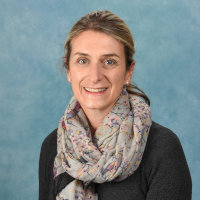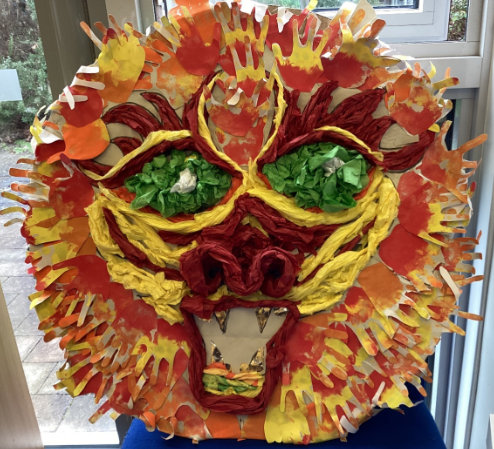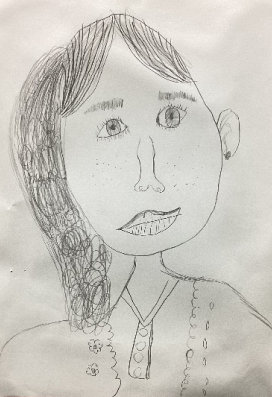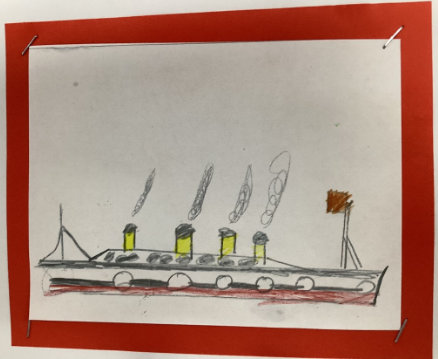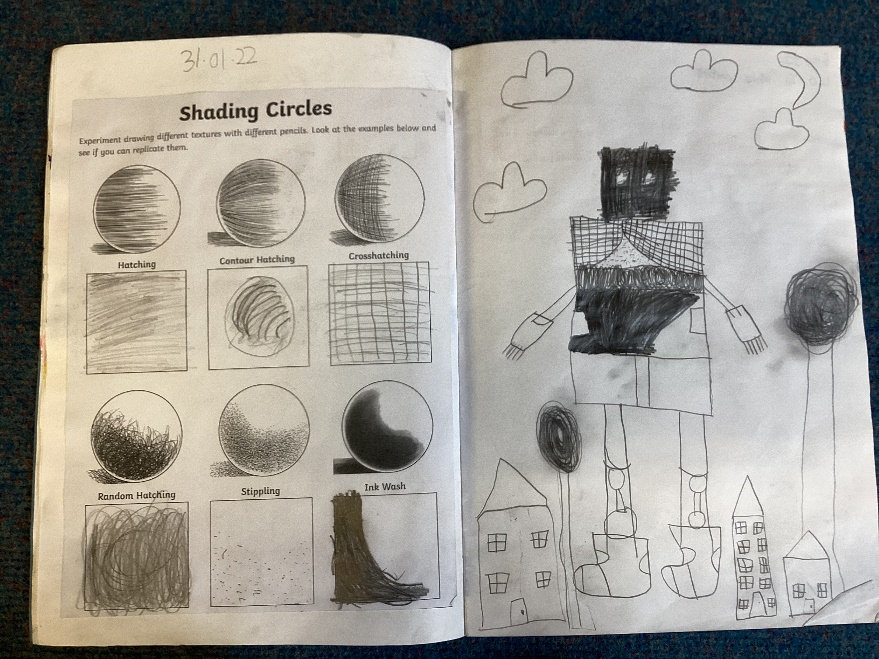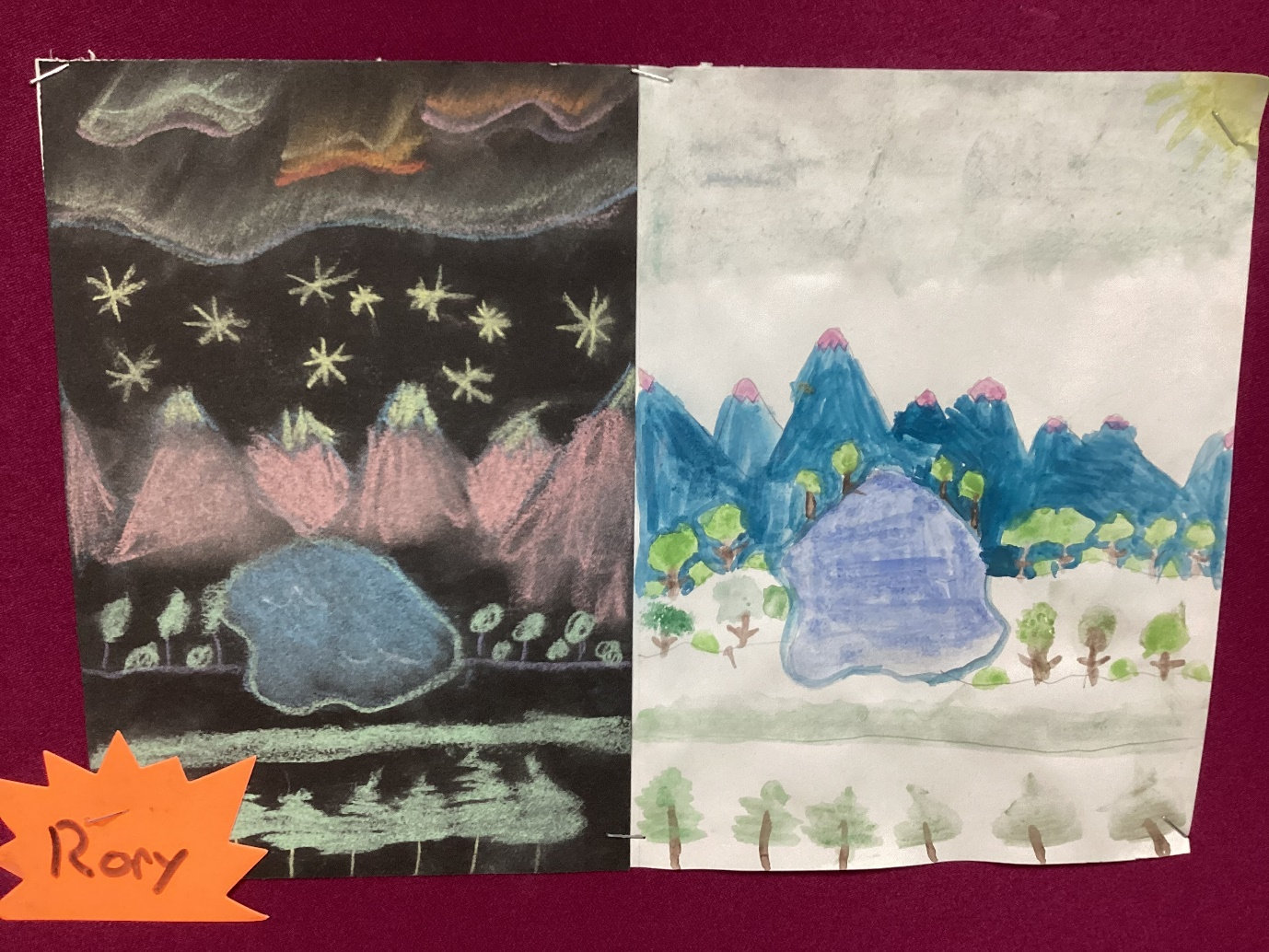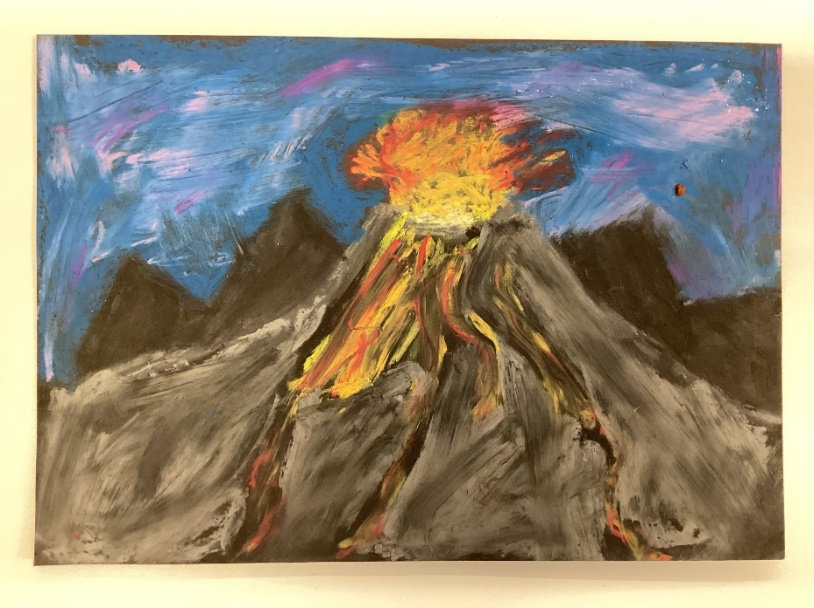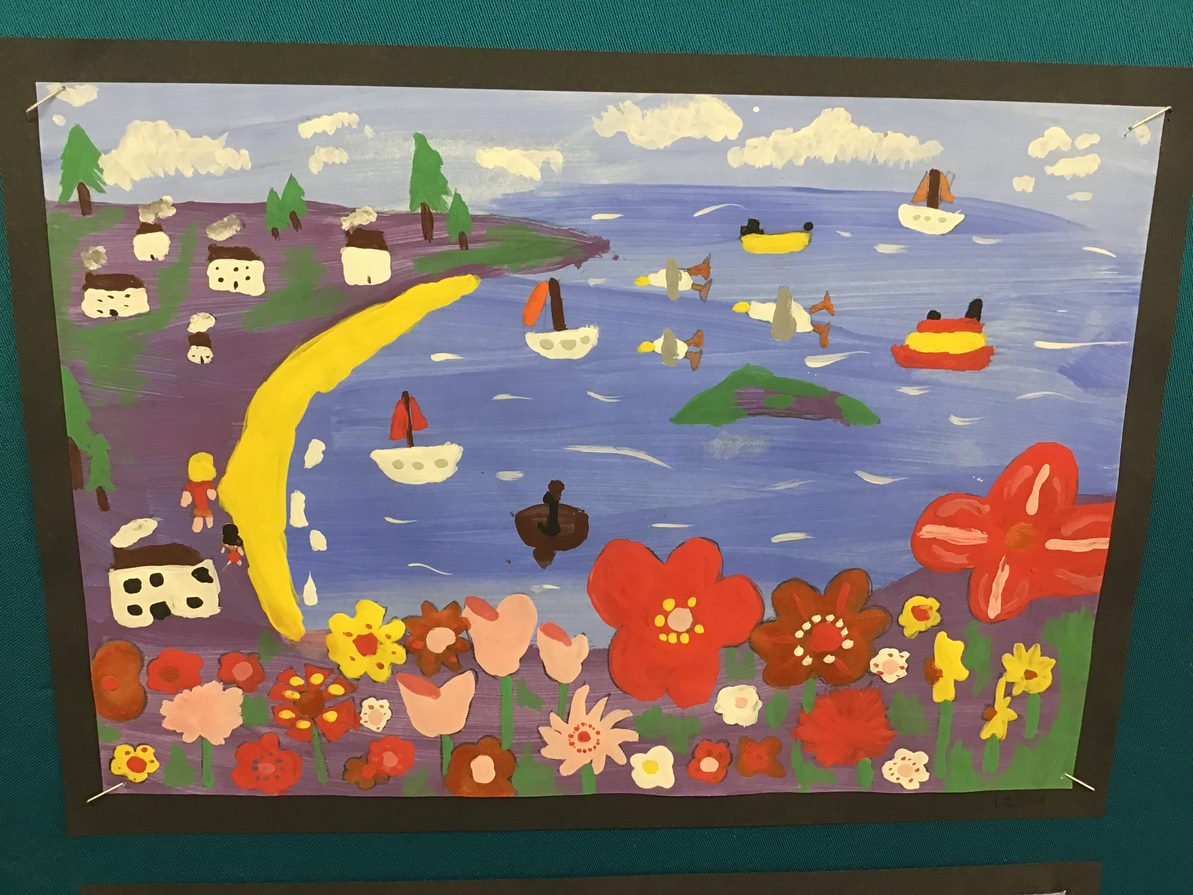Art & design curriculum
Intent
At Saint James Primary School, we believe that Art and Design plays a vital role in nurturing our students' creativity and artistic skills while embodying our core values of love, respect, and courage. We equip them with the artistic skills and abilities to take risks with their ideas, express their love of art, and make positive changes in themselves, their community and God’s wider world.
Through Art, our students are inspired to explore their imagination, experiment with various art techniques, and demonstrate proficiency in drawing, painting, sculpture, collage, and textiles. They have the opportunity to work both independently and collaboratively.
We understand the significance of Art in fostering cultural understanding and appreciation of God’s world. Respecting diverse cultures helps us understand, and interpret their expressions, and influences us to care with courage.
By introducing our students to great artists and designers, we empower them to draw inspiration from diverse cultural and historical perspectives. Our students are encouraged to use their knowledge and skills to create innovative and relevant artwork that reflects their own experiences and identity.
In addition to the curriculum, we provide our students with extracurricular activities and easy access to art resources, offering them enriching experiences that further motivate their artistic interests. Our students take pride in showcasing their artwork in our learning environment and acknowledge the positive impact Art has on their overall well-being.
At Saint James Primary School, we aspire for our students to become courageous artists who confidently apply the skills and techniques they have learned and strive for excellence in their artistic endeavours. We recognize that Art and Design are integral to our students' development, as they provide opportunities for learning, practicing, and applying essential knowledge and skills.
I embody the spirit of an Artist, I…
-
Generate creative ideas and use my imagination.
-
Explore and experiment with a wide range of art techniques.
-
Reflect on my work.
-
Know a variety of artists.
-
Understand and appreciate the role of art in cultural development within society.
We value art and design as a subject and strongly believe it is an ideal way to channel creativity. We have developed a skills-based curriculum that fosters exploration, curiosity with a range of media, presents challenges and provides children with the confidence to go beyond their comfort zone.
Implementation
• Art is part of the Early Years provision, both in continuous and enhanced provision. Children have daily opportunities for creating with materials and being imaginative. They experiment with colour, texture and form.
• Art projects are purposeful and link to the half-term project.
• Our art curriculum follows the National Curriculum.
• Art lessons are an integral part of the curriculum for students in Years 1-6, alternating with Design & Technology projects.
• Each year group participates in 2 or 3 Art projects throughout the year, each centred around an Artist and given skill focus.
• These projects consist of approximately 6 lessons, blocked across 3 afternoons in Key Stage 1 and 2.
• Children learn about a range of artists, both modern and classical, to deepen their understanding of God’s creatives.
• The vocabulary of Art is explicitly taught.
• Respect is instilled by learning about different cultures and taking care of art tools and equipment.
• Art is integrated within other subjects such as English, ICT, and Understanding of the World.
• Sketchbooks are used to document learning journeys, assess progress, and provide opportunities for reflection and improvement.
• Photographic evidence is also collected where necessary.
• A carefully mapped progression of skills ensures that each year group builds upon prior learning, developing art skills required for their stage of education.
• Gaps in knowledge are addressed through constructive feedback and evaluations.
• Children from across the school can take part in a weekly Art club after school.
• A progression of skills document identifies the particular art skill needed to be taught in each year group, which builds on prior learning.
• We have strong community links within our parish and often participate in whole school projects that involve working closely with our local church, Hopeweavers, and parent artists.
• Our links with Wilden school and the D'Art centre have allowed professionals to visit our school and teach us creative skills through planned workshops.
• For the past three years, we have participated in a county-wide project of raising awareness of Climate Change, showcasing our art at various venues including Winchester Cathedral, Hillier Arboretum, Southampton Art Gallery, The Eco Barn at Hamble Country Park, and The Outdoor Cathedral.
These opportunities have raised awareness of pressing issues communicated through art, empowered children's voices, and developed art skills.
“Every child is an artist.”
Pablo Picasso
Impact
Identification of Key Skills:
We have a clear progression of skills document that helps us identify key Art skills. Our teachers assess students' progress both at the point and after the point of teaching against these skills as part of their projects.
Emphasis on Knowledge:
We recognize the importance of knowledge in our Art projects and although we teach a skills based curriculum we feel it is necessary to ensure our children have a deep understanding of a variety of artists. We highlight sticky knowledge about our focus artists and give the children the opportunity to discuss and compare both in and outside of designated lessons. They do this alongside developing their artistic skills and put this into practise when completing their projects.
Monitoring Curriculum Provision:
Our Art subject leader actively monitors curriculum provision through various methods such as lesson observations, learning walks, planning scrutiny, work sampling and pupil conferencing. They also review outcomes for children through work sampling and pupil conferencing.
Assessment outcomes are regularly reviewed to evaluate the impact of the art curriculum and ensure the highest possible outcomes for children.
Art is enjoyed by the children, teachers, parents, and community members, empowering children to express their inner voice as artists.
In our school, believing in creativity and the creative process are good and beautiful ways of worshiping God. Our creativity reflects God as the ultimate creator. God made all things, and his mercy and love is repeatedly reshaping and restoring us, especially through art.
“I praise you, for I am fearfully and wonderfully made. Wonderful are your works; my soul knows
it very well."
Psalm 139:14
Curriculum overview
A summary of the Art curriculum can be found in the accordian container below:
!
WarningFor additional information regarding the curriculum please
email our Curriculum Leader
Autumn 1
Observational Drawing – Patterns in the natural world
- Draw lines of varying thickness.
- Use dots and lines to demonstrate pattern and texture.
- Use different materials to draw, for example pastels, chalk, felt tips.
- Respond positively to ideas.
Autumn 2
Toy Sculpture – use a variety of material and simple joins
- Use a variety of natural, recycled and manufactured materials for sculpting, e.g., clay.
- Use a variety of techniques, e.g., rolling, cutting, pinching.
- Use a variety of shapes, including lines and texture; try different materials and methods to improve.
Spring 1
Pattern
- Describe the work of famous, notable artists and designers.
- Express an opinion on the work of famous, notable artists.
- Use inspiration from famous, notable artists to create their own work and compare.
Spring 2
No Art listed - DT focus
Summer 1
Texture - Collage
- Use a combination of materials that have been cut, torn and glued.
- Sort and arrange materials.
- Add texture by mixing materials explore ideas.
Summer 2
Orla Kiely Inspired Printing and Creating Patterns
- Copy an original print.
- Use a variety of materials, e.g., sponges, fruit, blocks.
- Demonstrate a range of techniques, e.g., rolling, pressing, stamping and rubbing.
Autumn 1
No Art listed - DT focus
Autumn 2
Silhouettes of the London landscape – Collage
- Use a combination of materials that have been cut, torn and glued.
- Sort and arrange materials.
- Add texture by mixing materials.
Spring 1
Queen Portraits - Paint
- Name the primary and secondary colours.
- Experiment with different brushes (including brushstrokes) and other painting tools.
- Mix primary colours to make secondary colours.
- Add white and black to alter tints and shades.
- Respond positively to ideas and starting points.
- Describe differences and similarities and make links to their own work.
Spring 2
No Art listed - DT focus
Summer 1
African patterns Edward Saidi Tingatinga Printing
- Copy an original print.
- Use a variety of materials, e.g. sponges, fruit, blocks.
- Demonstrate a range of techniques, e.g. rolling, pressing, stamping and rubbing.
Summer 2
No Art listed - DT focus
Autumn 1
Textiles African Prints
- Use a variety of techniques, e.g., printing, dyeing, weaving and stitching to create different textural effects.
- Understand that materials have both functional properties and aesthetic qualities.
- Explore and evaluate existing products, explaining the purpose of the product and whether it is designed well to meet the intended purpose.
- Demonstrate how to measure, cut, shape and join fabric with some accuracy to make a simple product.
- Join textiles with an appropriate sewing technique.
- When planning, start to explain their choice of materials and components including function and aesthetics.
- Test ideas out through using prototypes.
- Begin to select and use different and appropriate finishing techniques to improve the appearance of a product such as hemming, tie-dye, fabric paints and digital graphics.
Autumn 2
No Art listed - DT focus
Spring 1
Antony Gormley – Iron Man – Sculpture
- Make observations about starting points, and respond positively to suggestions.
- Adapt and refine ideas.
- Cut, make and combine shapes to create recognisable forms.
- Use clay and other malleable materials and practise joining techniques.
- Add materials to the sculpture to create detail.
Spring 2
Textiles – Purses
- Develop skills in stitching, cutting and joining.
- Use inspiration from famous artists to replicate a piece of work.
- Express an opinion on the work of famous, notable artists and refer to techniques and effect.
- Select appropriate materials, giving reasons.
Summer 1
Drawing - Monet
- Use sketchbooks to record ideas.
- Explore ideas from first-hand observations.
- Experiment with showing line, tone and texture with different hardness of pencils.
- Use shading to show light and shadow effects.
- Use different materials to draw, e.g., pastels, chalk, felt tips.
- Show an awareness of space when drawing.
Summer 2
No Art listed - DT focus
Autumn 1
Scandinavian landscapes / Northern Lights
- Reflect upon their work inspired by a famous notable artist and the development of their art skills.
- Use sketchbooks to record ideas.
- Explore ideas from first-hand observations.
- Use varied brush techniques to create shapes, textures, patterns and lines.
- Mix colours effectively using the correct language, e.g., tint, shade, primary and secondary.
- Create different textures and effects with paint.
Autumn 2
No Art listed - DT focus
Spring 1
Collage – Queen Victoria
- Use inspiration from famous artists to replicate a piece of work.
- Question and make observations about starting points, and respond positively to suggestions.
- Select colours and materials to create effect, giving reasons for their choices.
- Refine work as they go to ensure precision.
- Learn and practise a variety of techniques, e.g. overlapping, tessellation, mosaic and montage.
Spring 2
No Art listed - DT focus
Summer 1
Printing – Artists related to rivers
- Express an opinion on the work of famous, notable artists and refer to techniques and effect.
- Line, pattern, texture, form, record, detail, question, observe, refine.
- Use more than one colour to layer in a print.
- Replicate patterns from observations.
- Make printing blocks.
- Make repeated patterns with precision.
- Adapt and refine ideas.
Summer 2
No Art listed - DT focus
Autumn 1
Textiles (Dream Catchers) and Leonora Carrington South American Art/Artist
- Review and revisit ideas in their sketchbooks.
- Offer feedback using technical vocabulary.
- Think critically about their art and design work.
- Experiment with a range of media by overlapping and layering in order to create texture, effect and colour.
- Add decoration to create effect.
- Use key vocabulary to demonstrate knowledge and understanding in this strand: colour, fabric, weave, pattern.
Autumn 2
Printing – Silhouette Art WW1 Silhouette Art
- Review and revisit ideas in their sketchbooks.
- Offer feedback using technical vocabulary.
- Think critically about their art and design work.
- Design and create printing blocks/tiles.
- Develop techniques in mono, block and relief printing.
- Create and arrange accurate patterns.
- Use key vocabulary to demonstrate knowledge and understanding in this strand.
- Hapa-Zome, hammering, pattern, shape, tile, colour, arrange, collograph.
Spring 1
Turner- drawing and pastels
- Review and revisit ideas in their sketchbooks.
- Offer feedback using technical vocabulary.
- Think critically about their art and design work.
- Give detailed observations about notable artists’, artisans’ and designers’ work.
- Offer facts about notable artists’, artisans’ and designers’ lives.
- Use a variety of techniques to add effects, e.g., shadows, reflection, hatching and cross-hatching.
- Depict movement and perspective in drawings.
- Use a variety of tools and select the most appropriate.
Spring 2
No Art listed - DT focus
Summer 1
No Art listed - DT focus
Summer 2
No Art listed - DT focus
Autumn 1
Painting
- Review and revisit ideas in their sketchbooks.
- Offer feedback using technical vocabulary.
- Think critically about their art and design work.
- Create a colour palette, demonstrating mixing techniques.
- Use a range of paint (acrylic, oil paints, water colours) to create visually interesting pieces.
Autumn 2
No Art listed - DT focus
Spring 1
No Art listed - DT focus
Spring 2
Collage
- Add collage to a painted or printed background.
- Create and arrange accurate patterns.
- Use a range of mixed media.
- Plan and design a collage.
- Use key vocabulary to demonstrate knowledge and understanding in this strand: shape, form, arrange, fix.
- Give detailed observations about notable artists’, artisans’ and designers’ work.
- Offer facts about notable artists’, Bartisans’ and designers’ lives.
Summer 1
No Art listed - DT focus
Summer 2
Sculpture - Clay
- Use digital technology as sources for developing ideas.
- Plan and design a sculpture.
- Use tools and materials to carve, add shape, add texture and pattern.
- Develop cutting and joining skills e.g., using wire, coils, slabs and slips.
- Use materials other than clay to create a 3D sculpture.
